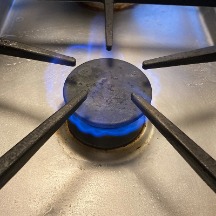Walking into your kitchen to make dinner appears relatively simple with a gas-powered stove readily available to cook your every desire. But while rotating the switch to turn on a gas stove, most people do not consider its health and environmental implications. According to a University of California Los Angeles (UCLA) report, over 90 percent of gas-powered appliances in California residences emit toxic pollutants such as carbon monoxide (CO), nitrogen oxides (NOx), particulate matter, and formaldehyde.
While gas furnaces and water heaters are big polluters no doubt, most of them are vented outdoors and are thus sending their CO and NOx emissions outside. But pollution from stoves and ovens are released indoors. The UCLA researchers found that in nine out of ten residences surveyed where gas ovens or stoves were in use, peak levels of nitrogen dioxide (NO2) inside the kitchen after cooking for one hour surpassed both state and national outdoor acute air quality standards. Such high concentrations of indoor air pollution are even more dangerous for smaller households—peak levels of NO2 in 98 percent of apartments surveyed exceeded state and national air quality standards.
Such pollution from gas-fired appliances like furnaces, water heaters and stoves present a serious health threat, increasing the likelihood of respiratory illness, cardiovascular disease, and premature death. For the elderly and children who are more susceptible to infections and diseases, elevated NO2 levels can be especially toxic. Additional risks of cooking with gas include increased risk of lung disease and vulnerability to novel viruses, not to mention the prompting of new allergies. Children risk a decreased IQ, learning deficits, and asthma. In fact, a 2013 report analyzing the impacts of indoor NO2 from gas stoves found that children who grew up in a home with a gas stove are 42 percent more likely to develop asthma than those who didn’t.
Should We All Be Ditching Our Gas Stoves in Favor Of Electric Models?
Our Space


Gas stoves are also a source of carbon monoxide, a pollution that is fatal at extremely high concentrations and can cause headaches, dizziness, vomiting, and nausea. Though morbidity linked to accidental CO is quite low, frequent exposure can increase the risk of lethal heart disease.
To avoid such health and environmental setbacks, gas appliances can be replaced by any number of zero-emission electric alternatives. The most common and effective stoves to replace gas stoves are induction cooktops and modern electric stoves. Electric stoves are powered by thermal conduction whereby electricity runs through a set of coils; induction cooktops are powered by electromagnetic currents that directly heat the cookware. Though initial installation costs of electric or induction stoves can be quite high, they consume much less energy than gas stoves and thus are more cost-effective in the long run.
More Info
Health Effects from Gas Stove Pollution
Pollution from Gas Appliances Endangers Our Health. Going Electric Can Help
Gas Stoves: Health and Air Quality Impacts and Solutions
To donate to Earthtalk
To send questions
To avoid such health and environmental setbacks, gas appliances can be replaced by any number of zero-emission electric alternatives. The most common and effective stoves to replace gas stoves are induction cooktops and modern electric stoves. Electric stoves are powered by thermal conduction whereby electricity runs through a set of coils; induction cooktops are powered by electromagnetic currents that directly heat the cookware. Though initial installation costs of electric or induction stoves can be quite high, they consume much less energy than gas stoves and thus are more cost-effective in the long run.
More Info
Health Effects from Gas Stove Pollution
Pollution from Gas Appliances Endangers Our Health. Going Electric Can Help
Gas Stoves: Health and Air Quality Impacts and Solutions
To donate to Earthtalk
To send questions
Advertisers | Contact Us | Events | Links | Media Kit | Our Company | Payments Pier
Press Room | Print Cover Stories Archives | Electronic Issues and Talk Radio Archives | Writer's Guidelines






